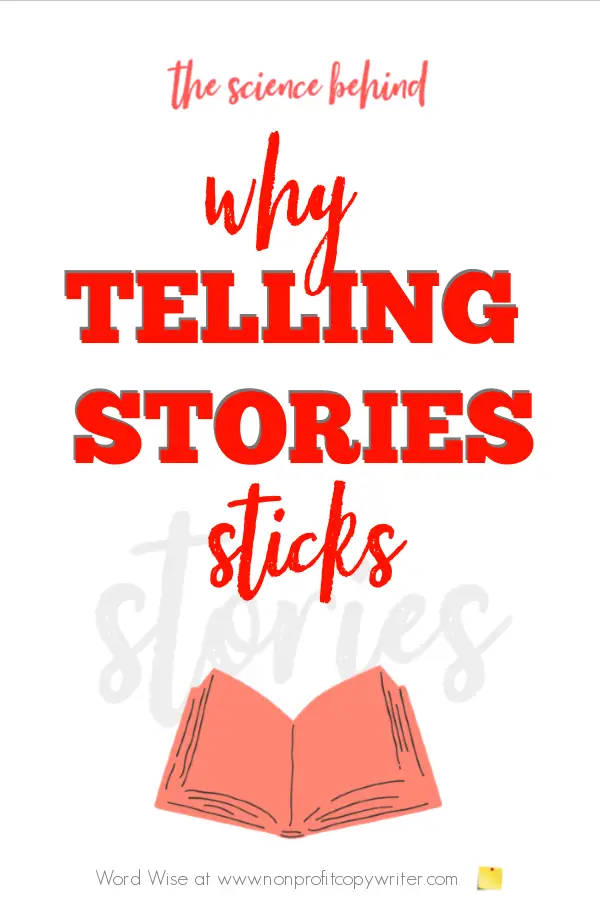Save Time: Get 5 Simple Writing Tips
you can put to use in 10 minutes
Why Telling Stories Sticks
Award-winning writer Kathy Widenhouse has helped hundreds of nonprofits and writers produce successful content , with 750K+ views for her writing tutorials. She is the author of 9 books. See more of Kathy’s content here.
Updated 10.14.25
Writers have long known it: telling stories makes content stick to readers. We use stories to illustrate a point and touch a reader’s heart.
But now, neuroscientists reveal that stories do more than that. A story creates an actual experience for the reader – an experience that she identifies with as part of the fabric of her senses, emotions, and memory.
Here’s what I mean.
In one of my earliest articles, I described my panicked Christmas Eve shopping spree. The next morning, when my parents and sisters opened their gifts, they were pleased … but I was frustrated at having spent too much money and disappointed at missing out on the anticipation I enjoy when choosing just the right gift for the right person. The story was the perfect jumping-off point for my article about the benefits of yearlong Christmas shopping.
Right now, you’re probably nodding along and reliving your own gift-giving horror story. You may even remember where you shopped or how late you stayed awake to wrap everything.
You’re connecting my story to yours and experiencing it for yourself.
Telling Stories Gives Your Brain a Workout
Reading is by no means a passive exercise, says Nicole K. Speer, Ph.D. Instead, as you process words on a page, your brain kicks into get and gets an amazing workout. That’s one reason telling stories has such a powerful impact on readers.
Nicole was lead author of a study conducted at Washington University in St. Louis and published in Psychological Journal.
Using functional magnetic resonance imaging (fMRI), the research team was able to track what happens when a reader processes words. Different areas of the brain fire up as you imagine, elaborate, and remember. Your brain actually creates the sensations of the experience described on the paper or the screen.
That’s why you’ll hear a reader say, “Reading that story made me feel as if I was there.” According to your brain, you were.
Telling Stories Gives Your Readers a Real-Life Experience
"When we read a story and really understand it, we create a mental simulation of the events described by the story,” says Jeffrey M. Zacks, study co-author.
The researchers had participants read four simple stories of less than 1,500 words – with one word displayed at a time on the computer screen. The researchers coded the stories with key activities, like grasping motions (“he pulled a light cord”) and spatial movement (“he went through the front door to the kitchen.”) While participants read, the team tracked the brain activity in real time.
When a participant read a section that referred to grasping motions, selective areas of his brain lit up. It was as if the reader reached up, clutched the cord, the and clicked on the light himself. The written word stirred up the senses he associated with that activity. The reader “lived” the activity in his mind while he read about it.
In other words, the human brain does not make much of a distinction between reading about an experience and undergoing it in real life.
Telling Stories Makes Content Stick
During the 1960s, educator Edgar Dale theorized that learners retain more information by what they do – as opposed to what they hear, read, or see. Actions leave the biggest impression on our minds.
That’s why a reader doesn’t remember as much content made up of facts or description. But when a story accompanies those facts, the reader’s brain gets a real-life experience. His brain believes he’s “doing” that experience. He remembers the story because his brain thinks he experienced it for himself.
And as Edgar Dale theorized, experience is the best teacher.
Which makes the story – and your point – stick.
More Story Writing Tips
A Simple 3-Part Story Writing Format for Powerful Content Stories ...
3 Tips for Writing Short Stories that Hook Your Readers ...
Why You MUST Master Persuasive Storytelling ...
How To Write and Use 3-Sentence Stories ...
12 Places to Look for Story Writing Ideas ...
How to Write a Story to Make a Point ...
3 Story Writing Mistakes to Avoid (If You Want to Make a Point) ...
The Simple 5-Step Story Structure for Writing Quick Content Stories ...
20 interview questions that guarantee a compelling story ...
Tips for getting stories from clients ...
How Stories Capture Readers with a Slice of Life ...
More tips on our Writing Stories Pinterest board ...
Return from Why Telling Stories Stick to Nonprofit Copywriter home
As an Amazon Associate I earn from qualifying purchases.
Share This Page

Named to 2022 Writer's Digest list
BEST GENRE/NICHE WRITING WEBSITE


Stop Wasting Time!
Grab your exclusive FREE guide, "5 Simple Writing Tips You Can Put to Use in 10 Minutes or Less"












